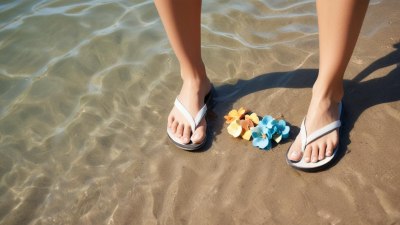The Science of Why Your Flip-Flops Disappear the Second You Step Near Water
Explore the intriguing phenomenon of lost flip-flops near water and the science behind it.

This image was created with the assistance of Freepik
The beach is often a place of relaxation and enjoyment, where the sound of waves crashing against the shore fills the air and the bright sun warms your skin. However, for many, this enjoyable experience is often marred by the mysterious disappearance of a beloved pair of flip-flops the moment they step near the water. What lies behind this peculiar tendency for footwear to vanish? In this article, we explore the science of why flip-flops seem to have a mind of their own whenever they come in contact with water.
The Nature of Flip-Flops
To understand the disappearance phenomenon, we first need to examine the nature of flip-flops themselves. Typically made from lightweight materials like rubber or foam, flip-flops are designed for comfort and easy wear. However, their very design—minimalist features and thin straps—renders them susceptible to various environmental factors, particularly water.
Buoyancy and Water Dynamics
One of the primary reasons flip-flops disappear near water is buoyancy. When you walk into the water, particularly in a beach setting with waves rolling in, the buoyant forces act on your flip-flops as well as your body. When submerged, the flip-flops can easily float away if they lose their grip on your feet. The buoyancy created by water displacement can be strong enough to lift flip-flops off your feet, especially for those that have not secured their fit properly. In this context, the design weaknesses of flip-flops become evident—they often have minimal foot retention, which is conducive to slipping off in water.
The Influence of Sand
Another contributing factor that you cannot ignore is the sand. Beaches are usually sandy and, when mixed with water, create a slippery composite. Each step taken on wet sand can lead to your flip-flops becoming covered, making them heavier and more likely to slip off. The combination of wet sand and the incessant roaming waves creates unpredictable conditions for your footwear. It’s not uncommon for flip-flops to become half-buried in the sand, leading them to be overlooked or even mistaken for random pieces of debris. Additionally, your natural body movements, such as walking, can displace sand, causing your footwear to become partially or fully exposed to water, hence leading to unforeseen loss.
The Sneaky Waves
As waves dance on the shore, their relentless pursuit often captures flip-flops that are lying nearby. Whether you are resting on the beach or running along the water's edge, a sneak wave can sweep in unexpectedly, pulling flip-flops into the tide. This can happen in less than an instant, and often you won't even realize it's happening until it's too late. The rapid inconsistency of wave patterns also means that your footwear can be in danger at any moment. Even if you think you've positioned them safely on dry sand, a sudden surge can easily send them floating away. It's like a game of hide-and-seek with the ocean, where, unluckily, you never seem to win.
The Human Element
Despite the science behind the physical interactions between flip-flops and water, human factors also play a significant role in these disappearance incidents. Habits like leaving flip-flops unattended near the water can contribute to their loss. Many beachgoers, especially children, may not fully understand the importance of securing or keeping an eye on their sandals. In the midst of playing, swimming, or socializing, flip-flops can easily be kicked aside or forgotten, becoming victims of beach chaos. Additionally, impulsive decisions, such as sprinting towards the waves without properly securing footwear or choosing to walk deeper into the water while wearing loose-fitting sandals, can exacerbate the risk of losing them.
The Environmental Impact
Moreover, the environment plays a significant role in the lifecycle of flip-flops. Unlike sneakers or other types of footwear, flip-flops are not designed for durability. Their lightweight materials often mean that they are not meant to withstand the rough conditions of ocean tides or aggressive currents. Once they are lost to the water, flip-flops can become part of marine pollution, affecting marine life and ecosystems. Scholars and environmentalists are increasingly raising awareness about the waste produced by discarded footwear and the consequences of rubber and plastic making their way into our oceans.
Mitigating the Loss of Flip-Flops
So how can you mitigate the misfortune of losing your flip-flops when stepping near water? One effective approach is utilizing flip-flops with better straps and fit. Options that feature thicker or more secure fasteners can help ensure that once you put them on, they remain on. Brands that offer ergonomic designs that conform to your feet can make a considerable difference in how securely they stay during rigorous activities like walking on the beach or during sudden wave encounters.
Investigative Strategies
Another effective action is to become an investigative beachgoer. Using wrist straps or removable cords that can attach your sandals either to your wrist or a secured bag while you're enjoying water-based activities can prevent flip-flop loss. Additionally, a designated landing area for shoes can help everyone in your group keep track of them while swimming, sunbathing, or participating in beach sports. For families and groups, enforcing a group agreement can establish an understanding of the importance of keeping all footwear accounted for when at the beach.
The beach may be a place of joy and serenity, but that enjoyment can often be overshadowed by the vexing phenomenon of disappearing flip-flops. Understanding the science behind the buoyancy, the water dynamics, the influence of sand, and the role human behavior plays in this mystery can arm beachgoers with knowledge to better protect their favorite pairs. Through improved choice in footwear, heightened awareness of environmental impacts, and collaborative efforts to secure and track belongings, we can redeem our summer days lost to flip-flop disappearances, letting us enjoy our relaxing moments without worrying about footwear mishaps. So, next time you venture to the shore and step near water, remember the potential pitfalls—and make sure your flip-flops don't become just another missing pair in the vastness of sandy shores.











